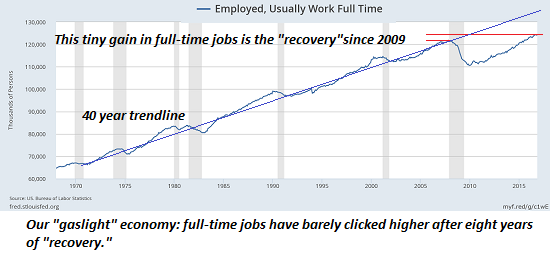Japan is a global leader is how to gracefully manage stagnation.
Although our leadership is too polite to say it out loud, they’ve embraced stagnation as the new quasi-official policy. The reason is tragi-comically obvious: any real reform would threaten the income streams gushing into untouchably powerful self-serving elites and fiefdoms.
In our pay-to-play centralized form of governance, any reform that threatens the skims, privileges and perquisites of existing elites and fiefdoms is immediately squashed, co-opted or watered down.
So the power structure of the status quo has embraced stagnation as a comfortable (except to those on the margins) and controllable descent that avoids the unpleasantness and uncertainty of crisis. We all know that humans quickly habituate to gradual changes in circumstances, and that if the changes are gradual enough, we have difficulty even noticing the erosion.
So wages/salaries stagnate, inflation eats away at the purchasing power of our net income, junk fees, tolls and taxes notch higher by increments too modest to trigger protest, fundamental civil liberties are chipped away one small piece at a time, healthcare costs rise every year like clockwork, and the gap between the bottom 95% and the top 5% widens, as does the gap between the top .1% and the bottom 99.9%, productivity stagnates, the growth rate of new businesses stagnates, but it’s all so gradual that we no longer notice except to sigh in resignation.
Japan is a global leader is how to gracefully manage stagnation. Here’s how Japan is managing to maintain a comfortable secular stagnation:
Japan’s central bank creates a ton of new currency every year, which it uses to buy Japan’s government debt/bonds. This keeps interest rates near-zero, so the cost of government borrowing is kept minimal.
This also gives the government a ton of new cash to spend that it doesn’t have to raise from additional taxes. The government then spends this “nearly free” money (i.e. deficit spending) to keep the whole stagnating machine glued together.
To keep asset prices comfortably elevated, Japan’s central bank creates additional gobs of currency out of thin air every year to buy assets such as stocks and corporate bonds.
It helps if domestic and global investors are willing to buy bonds yielding near-zero, but if not, no problem, the central bank can just create another trillion of new currency and buy all newly issued government bonds. What’s another trillion between friends?
|
There are only two potential spots of bother in this comfy setup:
1. If all this new currency is no longer accepted as having much purchasing power by the rest of the world
2. Inflation arises despite the tender machinations of the central bank and government.
Here are some snapshots of secular stagnation in the U.S.: here’s productivity:
|
US Productivity Growth, 1980 - 2017 |
| New business growth: |
Number of Firms Annual Change, 1990 - 2013 |
| Fulltime employment: |
Full Time Employers, 1970 - 2015 |
My new book is The Adventures of the Consulting Philosopher: The Disappearance of Drake. For more, please visit the book's website.
Full story here
Are you the author?
Previous post
See more for
Next post
Tags: newslettersent











































